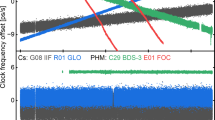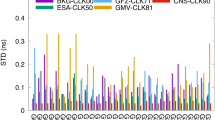Abstract
In real-time precise point positioning (RT-PPP), PPP one-way timing is used to steer local oscillators, but the timing performance could be significantly affected by the datum stability of the satellite clock product. To measure the stability of a satellite clock datum relative to the hydrogen maser (H-MASER) clock, a new GNSS satellite clock datum stability assessing model based on the overlapping Allan variance (AVAR) is proposed for both PPP one-way timing and time synchronization. Experiments were carried out with nine Global Navigation Satellite System (GNSS) stations at time laboratories with an external H-MASER clock to analyze the datum stability performance. In the experiments, RT satellite products from five RT Analysis Centers (ACs): CNES, ESA, GFZ, GMV, WHU, and the final satellite product from IGS were used in the comparison. Results show that the datum stability of all RT products tended to be similar, i.e., 6 to 8E−15/day, where WHU and GMV outperformed other RT ACs. Moreover, these datum stability results indicate that RT-PPP for steering local oscillators improves stability to 6 to 8E−15/day when selected with an appropriate RT product. The estimation noise in all RT ACs was at about the same level, i.e., 1 to 2E−15/day, but WHU delivered the most stable performance. Thus, datum stability is an effective guide for setting parameters and making long-term stability predictions when steering local oscillators, and satellite clock datum stability can be measured conveniently and quickly using the GNSS satellite clock datum stability assessing model proposed in this paper.






Similar content being viewed by others
Data availability
GNSS data are released by the IGS data center CDDIS at https://cddis.nasa.gov/archive/. The RT product files used in the experiment can be accessed from ftp://120.27.221.11/RT_011_046_2022/, username: share, password: 123456.
References
Allan DW (1987) Time and frequency (time-domain) characterization, estimation, and prediction of precision clocks and oscillators. IEEE Trans Ultrason Ferroelectr Freq Control 34(6):647. https://doi.org/10.1109/t-uffc.1987.26997
Ge Y, Ding S, Qin W, Zhou F, Yang X (2020) Carrier phase time transfer with Galileo observations. Measurement. https://doi.org/10.1016/J.MEASUREMENT.2020.107799
Gu S, Dai C, Fang W, Zheng F, Wang Y, Zhang Q, Lou Y, Niu X (2021) Multi-GNSS PPP/INS tightly coupled integration with atmospheric augmentation and its application in urban vehicle navigation. J Geodesy. https://doi.org/10.1007/S00190-021-01514-8
Gu S, Wang Y, Zhao Q, Zheng F, Gong X (2020) BDS-3 differential code bias estimation with undifferenced uncombined model based on triple-frequency observation. J Geodesy: Contin Bull Géodésique Manuscripta Geodaetica. https://doi.org/10.1007/s00190-020-01364-w
Guo W, Song W, Niu X, Lou Y, Gu S, Zhang S, Shi C (2019) Foundation and performance evaluation of real-time GNSS high-precision one-way timing system. GPS Solut. https://doi.org/10.1007/s10291-018-0811-1
Lei Y, Tan J, Guo W, Cui J, Liu J (2019) Time-domain evaluation method for clock frequency stability based on precise point positioning. IEEE Access 7:132413–132422. https://doi.org/10.1109/ACCESS.2019.2940515
Li G, Lin Y, Shi F, Liu J, Yang Y, Shi J (2018) Using IGS RTS products for real-time subnanosecond level time transfer. In: 9th China Satellite Navigation Conference (CSNC) - Location, Time of Augmentation, Harbin, Peoples Republic of China. https://doi.org/10.1007/978-981-13-0005-9_40
Liu T, Jiang W, Laurichesse D, Chen H, Liu X, Wang J (2020) Assessing GPS/Galileo real-time precise point positioning with ambiguity resolution based on phase biases from CNES. Adv Space Res 66(4):810. https://doi.org/10.1016/j.asr.2020.04.054
Lou Y, Zheng F, Gu S, Liu Y (2015) The impact of non-nominal yaw attitudes of GPS satellites on kinematic PPP solutions and their mitigation strategies. J Navig 68(4):718. https://doi.org/10.1017/S0373463315000041
Luo X, Gu S, Lou Y, Cai L, Liu Z (2020) Amplitude scintillation index derived from C/N0 measurements released by common geodetic GNSS receivers operating at 1 Hz. J Geodesy: Contin Bull Géodésique Manuscripta Geodaetica. https://doi.org/10.1007/s00190-020-01359-7
Luo X, Lou Y, Gu S, Li G, Xiong C, Song W, Zhao Z (2021) Local ionospheric plasma bubble revealed by BDS Geostationary Earth Orbit satellite observations. GPS Solut. https://doi.org/10.1007/S10291-021-01155-6
Mishagin KG, Lysenko VA, Medvedev SY (2020) A practical approach to optimal control problem for atomic clocks. IEEE Trans Ultrason Ferroelectr Freq Control 67(5):1080–1087. https://doi.org/10.1109/TUFFC.2019.2957650
Orgiazzi D, Tavella P, Lahaye FBI (2005) Experimental assessment of the time transfer capability of Precise Point Positioning (PPP). In: IEEE International Frequency Control Symposium, 345 E 47TH ST, New York, NY 10017 USA. https://doi.org/10.1109/FREQ.2005.1573955
Ouyang C, Shi J, Huang Y, Guo J, Xu C (2021) Evaluation of BDS-2 real-time orbit and clock corrections from four IGS analysis centers. Measurement. https://doi.org/10.1016/j.measurement.2020.108441
Petit G, Jiang ZBI (2007) Precise point positioning for TAI computation, 345 E 47TH ST, New York, NY 10017 USA. https://doi.org/10.1109/FREQ.2007.4319104
Pireaux S, Defraigne P, Wauters L, Bergeot N, Baire Q, Bruyninx C (2010) Higher-order ionospheric effects in GPS time and frequency transfer. GPS Solut 14(3):267–277. https://doi.org/10.1007/s10291-009-0152-1
Qin W, Ge Y, Zhang Z, Su H, Wei P, Yang X (2020) Accounting BDS3–BDS2 inter-system biases for precise time transfer. Measurement. https://doi.org/10.1016/j.measurement.2020.107566
Rønningen OP, Danielson M (2019) A novel PPP Disciplined Oscillator. In: 2019 Joint conference of the IEEE international frequency control symposium and European frequency and time forum (EFTF/IFC). https://doi.org/10.1109/FCS.2019.8856034
Shi C, Guo S, Gu S, Yang X, Gong X, Deng Z, Ge M, Schuh H (2019) Multi-GNSS satellite clock estimation constrained with oscillator noise model in the existence of data discontinuity. Springer, Berlin, Heidelberg 93(4):515. https://doi.org/10.1007/s00190-018-1178-3
Wu JT, Wu SC, Hajj GA, Bertiger WI, Lichten SM (1993) Effects of antenna orientation on GPS carrier phase. Manuscripta Geodaetica (No.2), 91–98
Wübbena G (1988) GPS carrier phases and clock modeling. GPS-Tech Appl Geodesy Surv. https://doi.org/10.1007/BFb0011350
Yang X, Gu S, Gong X, Song W, Lou Y, Liu J (2019) Regional BDS satellite clock estimation with triple-frequency ambiguity resolution based on undifferenced observation. GPS Solut. https://doi.org/10.1007/s10291-019-0828-0
Yao Y, He Y, Yi W, Song W, Cao C, Chen M (2017) Method for evaluating real-time GNSS satellite clock offset products. GPS Solut 21(4):1417–1425. https://doi.org/10.1007/s10291-017-0619-4
Zhao Q, Wang Y, Gu S, Zheng F, Shi C, Ge M, Schuh H (2019) Refining ionospheric delay modeling for undifferenced and uncombined GNSS data processing, vol 93(4). Springer, Berlin, Heidelberg. https://doi.org/10.1007/s00190-018-1180-9
Zumberge JF, Heflin MB, Jefferson DC, Watkins MM, Webb FH (1997) Precise point positioning for the efficient and robust analysis of GPS data from large networks, vol 102(B3). Wiley, Hoboken. https://doi.org/10.1029/96JB03860
Acknowledgements
This work was supported by the National Natural Science Foundation of China under Grant 41974038 and 42174029. The authors show great gratitude to IGS for providing data and products.
Author information
Authors and Affiliations
Contributions
Author WG and SG designed the research; WG, HZ, FM, and SG performed the research; XG, CX, and SG provided the region products; WG, HZ and SG analyzed the result; WG, HZ, and SG drafted the paper. All authors discussed, commented on, and reviewed the manuscript.
Corresponding author
Appendices
Appendix A
The satellite clock double difference, i.e., the difference between WHU RT product and IGS final product, and further between satellites, from DOY (day of the year) 016, 2022 is presented in Fig. 7 to show the existence of \({t}_{0}^{{s}_{i}}\) (Yao et al. 2017). As shown in Fig. 7, \({t}_{0}^{{s}_{i}}\) is rather stable.
Appendix B
To confirm that the cross-term of two independent power law clock noise with a similar noise parameter is one or two orders lower than the Allan deviation of each term, we used Stable32 software (http://www.wriley.com/) to generate a noise sequence n1 and n2 with the strategy of Table
5.
Where \(\tau \) represents the average time, \(N\) is the number of points, WPM is White Phase Modulation Noise, FPM is Flicker Phase Modulation Noise, WFM is White Frequency Modulation Noise, FFM is Flicker Frequency Modulation Noise, and RWFM is Random Walk Frequency Modulation Noise. The power law noises mentioned have a specific power spectral density of their fractional frequency fluctuations of the form \({\mathrm{S}}_{\mathrm{y}}\left({f}\right)\propto {{f}}^{\mathrm{a}}\), where \(f\) is the Fourier or sideband frequency in hertz; and \(a\) is the power law exponent. The \(a\, {\text {of}}\, \mathrm{WPM},\mathrm{ FPM},\mathrm{ WFM},\mathrm{ FFM},\mathrm{ and\, RWFM\, are }\,2, 1, 0, -1,\mathrm{ and }-2.\)
The Overlapping Allan deviation graph of n1, n2, and cross-term of n1 and n2 was as follows:
As shown in Fig. 8, the cross-term was about one order lower than that of the two origin random noises, i.e., n1 and n2. Note that the cross-term is not always positive, and the log–log diagram only presented the positive sequence.
In order to explain the effect of the cross-term between the reference and the noise on the reference, we simulate the similar overlapping Allan deviation curve by our experiment result and give the simulation parameters in Table
6.
We generate a noise sequence r and n as reference and noise. The Overlapping Allan variance graph of r, n, and the cross-term of r and n was as follows (Fig. 9).
The effect of the cross-term on reference needs to be discussed here because the noise has been detached from the reference. From the simulation results, the cross-term on the impact of the reference is minimal.
Rights and permissions
Springer Nature or its licensor (e.g. a society or other partner) holds exclusive rights to this article under a publishing agreement with the author(s) or other rightsholder(s); author self-archiving of the accepted manuscript version of this article is solely governed by the terms of such publishing agreement and applicable law.
About this article
Cite this article
Guo, W., Zuo, H., Mao, F. et al. On the satellite clock datum stability of RT-PPP product and its application in one-way timing and time synchronization. J Geod 96, 52 (2022). https://doi.org/10.1007/s00190-022-01638-5
Received:
Accepted:
Published:
DOI: https://doi.org/10.1007/s00190-022-01638-5







